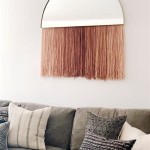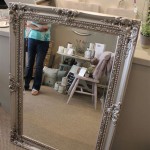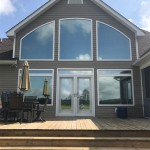Decorative Wall Mirrors: Enhancing Spaces with Light and Style
Decorative wall mirrors are more than just reflective surfaces; they are versatile design elements capable of transforming the aesthetic and functionality of any room. Their ability to amplify light, create the illusion of space, and serve as focal points makes them a popular choice for interior designers and homeowners alike. Selecting the right decorative wall mirror involves considering various factors, including style, size, placement, and the overall design scheme of the space.
The evolution of mirrors from simple, practical objects to decorative items reflects a shift in perspective regarding their role in interior design. Early mirrors were expensive and rare, accessible only to the wealthy. As manufacturing processes improved and costs decreased, mirrors became more widely available, leading to experimentation with shapes, sizes, and frames. Today, decorative wall mirrors encompass a vast array of styles, from minimalist and modern to ornate and antique, catering to diverse tastes and design preferences.
Understanding the Benefits of Decorative Wall Mirrors
Decorative wall mirrors offer a multitude of benefits beyond their primary function of reflection. These advantages contribute significantly to the overall ambiance and perceived quality of a living space. Understanding these benefits is crucial for making informed decisions about incorporating mirrors into interior design projects.
One of the primary benefits is the ability to enhance natural light. Mirrors strategically placed near windows or light sources reflect and redistribute light throughout the room, brightening dark corners and mitigating the need for excessive artificial lighting. This is particularly valuable in smaller spaces or rooms with limited natural light, where mirrors can create a brighter and more inviting environment. The increased light levels can also positively impact mood and productivity.
Another significant advantage is the illusion of increased space. By reflecting the surrounding environment, mirrors create a sense of depth and expansion, making rooms feel larger and more open. This is particularly effective in narrow hallways, small bedrooms, or confined living areas. A carefully positioned large mirror can visually double the size of a room, creating a more comfortable and less claustrophobic atmosphere. The principle works by tricking the eye into perceiving a continuation of the space beyond the mirror's surface.
Decorative wall mirrors also serve as focal points, drawing the eye and adding visual interest to a room. A statement mirror with a unique frame or an unusual shape can become a conversation piece and a defining element of the décor. They can be used to accentuate architectural features, highlight artwork, or complement existing furniture arrangements. The selection of the frame material, color, and design can significantly influence the overall aesthetic and contribute to the desired style, whether it be contemporary, traditional, or eclectic.
Furthermore, decorative wall mirrors can conceal imperfections or draw attention away from undesirable aspects of a room. A strategically placed mirror can mask an uneven wall, camouflage a small alcove, or redirect the focus from a less appealing area. This makes them a valuable tool for addressing spatial challenges and enhancing the overall visual harmony of a room. The placement requires careful consideration of what will be reflected and whether it enhances or detracts from the overall aesthetic.
Finally, mirrors can be used to create symmetry and balance within a room. Using pairs of identical mirrors on either side of a fireplace, doorway, or piece of furniture can create a sense of order and visual harmony. This technique is particularly effective in formal or traditional settings where symmetry is a key design principle. The matching mirrors visually anchor the space and contribute to a sense of equilibrium and stability.
Choosing the Right Style and Size
The selection of the appropriate style and size of a decorative wall mirror is paramount to achieving the desired aesthetic and functional impact. The style should complement the existing décor, while the size should be proportional to the wall space and the overall dimensions of the room. Careful consideration of these factors will ensure that the mirror enhances rather than detracts from the overall design.
Style is a critical consideration. From sleek and minimalist frameless mirrors to ornate and vintage-inspired designs, the options are virtually limitless. Contemporary styles often feature clean lines, geometric shapes, and metal or glass frames. Traditional styles typically incorporate elaborate carvings, gilded finishes, and antique details. Bohemian styles might include macrame or rattan frames, while rustic styles may feature reclaimed wood or metal accents. The chosen style should align with the prevailing design aesthetic of the room to create a cohesive and harmonious look.
The size of the mirror is equally important. A mirror that is too small will appear insignificant and may not effectively reflect light or create the illusion of space. Conversely, a mirror that is too large can overwhelm the room and create an imbalanced aesthetic. As a general rule, the size of the mirror should be proportional to the wall space where it will be placed. For example, a large wall in a living room might accommodate a large, statement mirror, while a small hallway might be better suited to a smaller, more discreet mirror.
Consider the purpose of the mirror when determining the appropriate size. If the mirror is intended primarily for practical purposes, such as checking one's appearance, it should be large enough to provide a clear and full reflection. If the mirror is primarily decorative, the size can be dictated more by aesthetic considerations. However, even decorative mirrors should be large enough to make a visible impact and contribute to the overall design scheme.
Shape is another important aspect of style. Rectangular and square mirrors are versatile and can be used in a variety of settings. Round and oval mirrors offer a softer, more organic feel and can be particularly effective in bathrooms or bedrooms. Arched mirrors add a touch of elegance and sophistication, while irregularly shaped mirrors can create a more contemporary and artistic look. The shape of the mirror should complement the lines and shapes of the surrounding furniture and architectural elements.
The frame material and finish also play a significant role in the overall style of a decorative wall mirror. Metal frames, such as brass, silver, and chrome, are popular choices for contemporary designs. Wood frames, particularly those with natural finishes or distressed details, are well-suited for rustic or farmhouse styles. Painted frames offer a wide range of color options and can be used to coordinate with the room's color palette. The finish of the frame can also impact the overall look. A glossy finish will reflect more light and create a more formal appearance, while a matte finish will offer a more subtle and understated look.
Placement and Installation Considerations
Proper placement and secure installation are crucial for maximizing the impact and ensuring the safety of decorative wall mirrors. Incorrect placement can diminish the mirror's aesthetic appeal and functional benefits, while improper installation can lead to accidents and damage. These considerations are essential for a successful integration of the mirror into the space.
Consider the viewing angle and what the mirror will reflect. Avoid placing mirrors where they will reflect clutter, unattractive views, or direct sunlight that could cause glare. Instead, position them to reflect desirable elements, such as natural light, artwork, or scenic views. The viewing angle should be comfortable and natural, allowing for a clear and unobstructed reflection. Consider the height of the mirror in relation to the height of the people who will be using it most frequently.
The height at which a mirror is hung is also important. In general, the center of the mirror should be at eye level for the average person. This will ensure that the mirror is both functional and visually appealing. In bathrooms, mirrors are typically hung above the vanity, with the bottom edge of the mirror a few inches above the backsplash. In living rooms or hallways, mirrors can be hung at varying heights, depending on the desired effect. However, it is important to maintain a consistent height for multiple mirrors hung in the same area.
When installing a decorative wall mirror, safety should be the top priority. Use appropriate hanging hardware, such as D-rings, wire, or cleats, that are rated to support the weight of the mirror. Ensure that the hardware is securely attached to the wall using appropriate anchors, especially if the wall is made of drywall or plaster. For larger and heavier mirrors, it is recommended to use multiple anchors or to attach the mirror directly to wall studs. Consulting a professional installer is advisable for particularly large or heavy mirrors.
Before installation, carefully measure and mark the location of the mirror on the wall. Use a level to ensure that the mirror will be hung straight. Pre-drill pilot holes if necessary, and then attach the hanging hardware to the wall. Carefully lift the mirror into place and secure it to the hardware. Double-check the alignment and stability of the mirror before releasing it. If the mirror is particularly heavy or awkward to handle, it is best to have assistance during installation.
Consider the surrounding environment when determining the placement of a decorative wall mirror. Avoid placing mirrors in areas where they are likely to be bumped or damaged. For example, in high-traffic areas, consider recessed mirrors or mirrors with protective frames. In bathrooms, ensure that the mirror is adequately ventilated to prevent fogging. In rooms with high humidity, choose a mirror with a moisture-resistant backing to prevent damage.
Finally, consider the lighting conditions in the room. Mirrors can be used to enhance both natural and artificial light. However, it is important to avoid placing mirrors where they will create glare or reflections that could be distracting or uncomfortable. Experiment with different lighting arrangements to find the optimal balance between light and reflection.

Buy Cloverleaf Art Deco Decorative Wall Mirror At 20 Off Retail Staunton And Henry

Shyfoy Jeweled Accent Wall Mirror 33 85 Inches Round Sparkly Decorative Mirrors For Decor Com

Timberly Wooden Decorative Wall Mirror For Living Room In Black Gold Color 24 X 16 Inch Buy At

Muausu Modern Wall Decorative Mirror Gorgeous Round Mirrors 32 X For Livingroom Bedroom Decor Living Room Accents

Cozayh Distressed Wood Frame Accent Mirror Rustic Farmhouse Style Decorative Wall Round Com

Wall Mirror Designs Elevate Your Home Decor

Kohros 24 In X 35 Rectangle Modern Decoration Wall Mirror Mu202404 9 The Home Depot

Buy Decorative Wall Mirror Large Rectangular Broe In

How To Choose The Ideal Wall Mirror For Your Room Majestic Glass

Tied Ribbons Decorative Wall Mirror For Home Living Room Bedroom Bathroom Wash Basin In Buy








